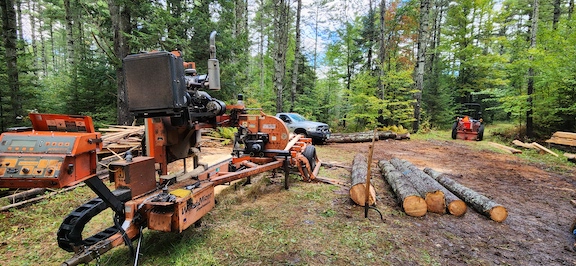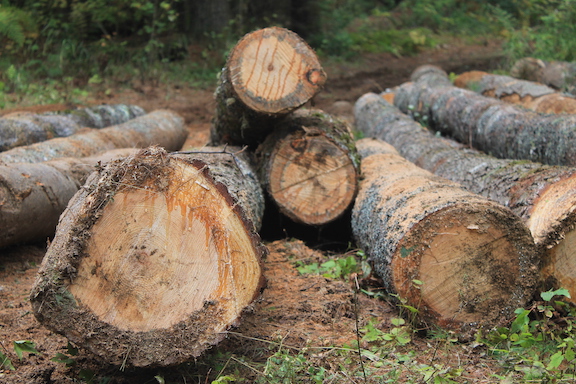By Noah Gleason-Hart
As a management philosophy, low-impact forestry recognizes that forests have an important role in reducing the effects of climate change and that we have an obligation as thoughtful managers to incorporate climate mitigation into our stewardship decisions. What does this mean, and how could a commitment to carbon forestry impact the way you manage your woods?
Forests mitigate climate change in two ways: carbon sequestration and carbon storage.
According to “Forest Carbon: An essential natural solution for climate change,” carbon storage is “the amount of carbon that is retained in a carbon pool in the forest.” Essentially, it is the carbon contained in the trees — living and dead — and soils of a forest, and it peaks when a forest is over 200 years old.
In contrast, carbon sequestration is “the process of removing carbon from the atmosphere for use in photosynthesis, resulting in the maintenance and growth of plants and trees,” which is at its highest when a forest is between 30 and 70 years old. Both play an essential role in climate mitigation but result from different management strategies, which we’ll discuss below.
As we increase our forests’ carbon sequestration and storage potential to reduce climate change, we also have to acknowledge that climate change is already impacting our forests. Drought events, weather patterns and growing insect populations threaten forests’ ecological integrity. Forests are naturally adaptable, resilient ecosystems, but they have limits, and human-caused climate change may overwhelm a forest’s capacity to absorb change on its own.
We can use thoughtful management to help forests adapt to climate change and maintain mitigation capacity over the long term by increasing species and age diversity, maintaining individual tree vigor and promoting species projected to do well in a changing climate.

However, mitigation and adaptation may be in conflict over the short term. For example, in a forest composed entirely of one species of large, 100-year-old trees, the best way to maintain sequestration and storage levels today would be to leave the stand unmanaged. Any harvest will reduce forest biomass and carbon potential. Passively managing a stand may be the right choice in many circumstances. However, a monoculture like this, which probably occurred due to past human intervention, may be less resilient to stressors, so a wind event or insect outbreak might drastically reduce the carbon capacity of this stand tomorrow. As an individual land manager, you must find a balance between mitigation and adaptation that fits your land.
Let’s explore two examples where climate mitigation and adaptation considerations play a leading role in active forest stewardship.
Growing large, old trees and releasing existing regeneration in MOFGA’s forest:
With guidance from a licensed consulting forester and significant community support, MOFGA has managed 125 acres of forested land in Unity since the 1990s. Twenty-five years of thoughtful management — coupled with high-quality soils — has left us with a forest of large trees and many management options.
For MOFGA’s ongoing work along the Pine Gate Road, they have chosen to continue growing the pine overstory, using crop tree release to remove competitors and concentrate growth on the most vigorous trees in the stand. With more carbon dioxide uptake to fuel the growth process, this thinning will increase sequestration rates as it increases tree diameter and storage capacity.
Climate considerations inform the way MOFGA conducts this crop tree release work. MOFGA prefers to use light equipment with a relatively small footprint, like farm tractors, and only harvest when ground conditions are dry. This minimal ground disturbance and careful approach keeps soil carbon intact and minimizes damage to residual trees’ bark that would slow growth and carbon sequestration rates. The small width minimizes our trail size and allows us to avoid cutting trees for operational, rather than silvicultural, reasons. We don’t have to harvest trees just to fit equipment in the stand, so we can leave a more heavily stocked residual stand with more carbon capacity.
Climate considerations also guide how we use the wood we cut. Though MOFGA may sell wood in the future, we currently maintain a hyper-local supply chain by having a mobile sawyer mill our logs for our use. In addition to reducing the carbon footprint of trucking, this allows us to turn logs that a traditional mill would turn away due to crook or other defects into carbon-storing framing lumber we can use for long-lived projects on MOFGA’s campus.
In our current operation, we leave the parts of the tree that do not have sawlogs in them — both tops and non-merchantable trees — lying in the woods rather than extracting them and selling them as pulp or biomass. With the low production tools used, it is more holistically valuable to MOFGA to let this wood store carbon, slowly releasing it as it rots, rather than burning it as biomass or putting it into short lived products, like paper.
If MOFGA’s management objective were to maximize financial returns, the organization would continue to grow crop trees until they reached economic maturity, a target diameter when the rate of return dips below an acceptable level. Economic maturity occurs long before a tree reaches ecological maturity, especially on long-lived species like white pine. Instead, MOFGA is willing to accept a lower financial return and will grow its trees longer with an eye towards their value as vigorous carbon sequesters when they are younger and as carbon storage when they age. Some large trees will eventually be harvested, and some will be left in the stand to grow old and die on their own.
Finally, though we value the large-diameter pines that dominate MOFGA’s forest, we also recognize that this even-aged, monoculture forest that grew up due to agricultural abandonment is not as resilient to stressors as it could be. Previous MOFGA harvests have removed small groups of overstory trees at once to promote the growth of another age class of trees. The current harvest continues this work by using dispersed pockets of group selection to bring more light on regeneration established previously. Over time these treatments will create a forest with several age classes and species better equipped to manage disturbance, even though it temporarily reduces sequestration and storage capacity in the stand.

Keeping land intact and rehabilitating high-graded forest in Southern Maine:
My wife and I recently purchased an approximately 30-acre woodlot in northern York County, and, like MOFGA, we have identified climate mitigation as an important objective of our management. However, our land has drastically different stand conditions than MOFGA’s forest, so we’ll have to take a very different path to meet our shared goals.
Before coming into my wife’s family in the 1990s, the land experienced a series of harvests that removed the best quality trees with no regard for future stand composition or quality. This high grading left some pockets of high-quality trees that have grown to sawlog size since the last commercial harvest 20 years ago. Still, the primary legacy of past management is a sea of diseased American beech sprouts and trees with severe butt log damage from logging equipment. Soil quality is generally much lower than in MOFGA’s forest, but the land can still grow large, healthy trees, especially white pine.
The most important thing we can do to maintain the climate mitigation potential of this site is to keep it forested and undeveloped. This is especially critical in an area like York County, where development pressure is high, and especially difficult because of high tax valuations. To ensure that we have the means to keep this land intact, we are exploring some of Maine’s current use tax programs, like the Open Space and Tree Growth tax programs. Participating in these programs would bring our tax valuation in line with the land’s capacity to grow trees and provide public access benefits. We have also applied for funding from the Natural Resource Conservation Service (NRCS) office to support hiring a licensed forester to write a management plan. An NRCS-approved plan will allow us to access funding that could cover some of the costs of stand improvement projects we’d like to carry out to improve tree quality and value.
We could leave our beech to grow, but most are affected by beech bark disease, which kills the tree and initiates a cycle of beech resprouting that can crowd out other species and create beech monocultures. Affected trees grow slowly and never reach large diameters, so they are not particularly valuable from a carbon sequestration or storage perspective. In addition, thoughtful commercial harvests may play an essential role in our ability to financially support keeping this land intact, and diseased beech has minimal value.
Instead, we want to diversify this stand and regenerate a new generation of trees. To do this, we are creating small patch cuts, less than a third of an acre in size. Within the patches, we are removing all of the diseased beech but retaining any healthy, long lived trees of other species and spacing any pine regeneration present. We are also saving any beech showing resistance to beech bark disease. Healthy beech trees are a critical and beautiful part of our forests! Though visually jarring, the high sunlight conditions in these patch cuts should allow other species to compete with the resprouting beech while also increasing the growth rates of existing trees with the potential to grow to large diameters. We also believe that over the longer term, our work will encourage the growth of a carbon-rich forest, even though our actions result in a loss of carbon now.
Finally, we have designated most of the trees already over 20 inches in diameter at breast height as legacy trees to remain forever unharvested. Some of these trees have quality sawlogs, so we are forgoing timber income because we recognize that they will provide a vital carbon storage component otherwise lacking in our young forest.
No matter the size or condition of your forest, you can prioritize climate imperatives. If you are interested in learning more, I suggest these two resources:
- “Forest Carbon: An essential natural solution to climate change” (masswoods.org)
- The Climate Change Response Network’s Menu of Adaptation and Mitigation Strategies and Approaches for Forest Carbon Management (forestadaptation.org)
This article was originally published in the winter 2022-23 issue of The Maine Organic Farmer & Gardener.
